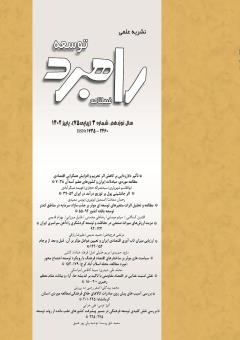بررسی آسیب های پیش روی صادرات کالاهای خلاق فرهنگی(مطالعه موردی: استان کرمانشاه)
محورهای موضوعی :
1 - دانشگاه رازی
2 - گروه جغرافیا، دانشکده ادبیات و علوم انسانی، دانشگاه رازی، کرمانشاه، ایران
کلید واژه: کلمات کلیدی: صادرات صنایع خلاق فرهنگی, کالاهای غیر نفتی, توسعه صادرات, استان کرمانشاه,
چکیده مقاله :
چكيده تنوع بخشی به صادرات کالاهای غیر نفتی یکی از اهداف اقتصاددانان و برنامه ریزان کشور بوده است؛ با این همه در بین کالاهای غیر نفتی توجه کمی به توانمندی های صادرات کالاهای خلاق فرهنگی شده است که این مقاله با هدف بررسی عوامل موثر بر صادرات کالاهای غیر نفتی انجام گرفته است. روش تحقیق کاربردی، توصیفی تحلیلی و با استفاده از ابزار پرسشنامه بوده است. روش نمونه گیری تصافی ساده بوده است. جامعه آماری بالغ بر 343 نفر از هنرمندان در عرصه نقاشی، نمایش، خوشنویسی، گرافیک، کتاب، مطبوعات مکتوب بوده است. نمونه تحقیق با استفاده از فرمول کوکران برابر با 182 نفر بوده است. پایایی تحقیق توسط آلفای کرونباخ با میانگین 79/0 مورد تایید قرار گرفت. روایی تحقیق نیز با استفاده از نظر متخصصان جامعه شناسی و هنر تایید شد. یافته ها نشان می دهند که 7 مولفه عوامل قانونی، مسائل بین المللی، چالش های داخلی، چالش های تولیدی، عوامل آموزشی، چالش های اقتصادی و ویژگی های صنایع خلاق بر صادرات صنایع خلاق فرهنگی موثر هستند نتایج حاصل از رگرسیون نشان می دهند که عوامل قانونی مهمترین مانع بر شر صادرات محصولات فرهنگی خلاق هستند. در مرتبه دوم مسائل بین المللی و چالش های تولید در داخل به عنوان مهمترین موانع قانونی صادرات صنایع خلاق معرفی شده اند. در نهایت یافته های آزمون کروسکال والیس نشان می دهد که تفاوت معنی داری بین چالش های فرهنگی صادرات کالاهای خلاق فرهنگی وجود ندارد. به عبارتی علی رغم تفاوت های ماهوی میان صنایع خلاق فرهنگی، چالش های صادراتی آن ها مشابه بوده و برای حل بخش بزرگی از مشکلات آن ها، می توان سیاست های کلی و مشابهی در پیش گرفت.
Aeizh Azmi Ali Khazaei Abstract Diversifying the export of non-oil goods has been one of the goals of the country's economists and planners; However, among non-oil goods, little attention has been paid to the capabilities of exporting creative cultural goods, which this article aims to investigate the factors affecting the export of non-oil goods. The research method was applied, descriptive, analytical and using a questionnaire tool. The sampling method was simple. The statistical population consisted of 343 artists in the fields of painting, drama, calligraphy, graphics, books, and written press. The research sample using Cochran's formula was equal to 182 people. The reliability of the research was confirmed by Cronbach's alpha with an average of 0.79. The validity of the research was also confirmed using the opinion of sociology and art experts. The findings show that 7 components of legal factors, international issues, domestic challenges, production challenges, educational factors, economic challenges and characteristics of creative industries are effective on the export of cultural creative industries. The results of the regression show that the factors Laws are the most important obstacle to the export of creative cultural products. Second, international issues and domestic production challenges have been introduced as the most important legal obstacles to the export of creative industries. Finally, the findings of the Kruskal Wallis test show that there is no significant difference between the cultural challenges of exporting creative cultural goods. In other words, despite the substantial differences between creative and cultural industries, their export challenges are similar and to solve a large part of their problems, general and similar policies can be adopted.
